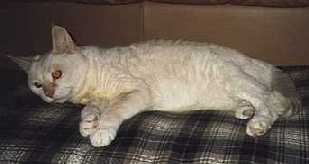Return
to the
Quality
of Life
main
page
STORIES
Chance
Fleabag
Seamus
Barney
|
Owner's descriptions of the
health & lifestyle of their diabetic pets.
For months before our
Samoyed Chance's  diagnosis, we suspected
something was wrong. He wasn't "himself", and I took him to the
vet again and again. It was devastating-- but also a kind of relief-- when
he was finally diagnosed with diabetes.
diagnosis, we suspected
something was wrong. He wasn't "himself", and I took him to the
vet again and again. It was devastating-- but also a kind of relief-- when
he was finally diagnosed with diabetes.
Chance was 7 years old when we found out he was diabetic. His blood glucose
levels were very high (in the 500's), and he panted, was restless at night,
obviously uncomfortable; and sometimes in very real distress. The vet
supported our home testing, which helped us track the efficiency of the
insulin and accelerated his regulation.
The most severe problems we encountered were the loss of Chance's eyesight,
and the deterioration of his coat. Like most diabetic dogs, Chance needed
regular ophthalmologist check-ups, and we learned he would go blind without
cataract surgery. Chance
had the surgery about a year after diagnosis, and this procedure was
serious and difficult. But he can see well now and there seem to be no side
effects.
He lost his undercoat completely. Before he was regulated I would take him
for a walk and could see his pink skin when the wind blew the fine white
hair of his coat. All the people that used to stop us and tell us what a
beautiful dog he was stopped to console us about our aged and ill Chance. He
was always high-spirited and happy and I'm glad he never understood how sick
and sorry he looked at that time.
But the insulin treatment, his change in diet and our careful schedule
finally did make a difference... in Chance's case it took two years. Chance
was trickier than most to regulate and I think many animals are like
Chance-- they just don't have nice, neat BG curves that make regulation so
simple.
Chance doesn't know he has diabetes, and he doesn't realize he is sick in
any way. He's a very happy boy, very puppy-like for his ten years, and I
don't believe that his disease will affect the quality of his life or life
span at all. His diabetes, if anything, has brought him closer to us, and us
to him.
We adjust to the changes necessary to keep Chance comfortable and healthy.
He is worth it in a million ways.

Fleabag
 is a cat diagnosed with diabetes on June 25, 1998 at the age of 17. Fleabag
has never been what most would called regulated. His bg numbers tend to stay
fairly high, even for a cat. My vets and I call him "stable". He
tends to thrive on numbers over 200 but clinical signs such as pu/pd, weight
loss, lethargy, etc. are nonexistent.
is a cat diagnosed with diabetes on June 25, 1998 at the age of 17. Fleabag
has never been what most would called regulated. His bg numbers tend to stay
fairly high, even for a cat. My vets and I call him "stable". He
tends to thrive on numbers over 200 but clinical signs such as pu/pd, weight
loss, lethargy, etc. are nonexistent.
Fleabag has suffered 2 bouts of pancreatitis since becoming diabetic. In
March, 2000, he lost his ability to walk. That disability has nothing to do
with his diabetes. After much testing by regular vets, a chiropractor/
acupuncturist and a neurologist, he was found to have a defect
or injury to his spinal column complicated by arthritis. This would have
happened even if he had not been diabetic.
His overall health at this point (October, 2000) is very good for a 19+ year
old cat. His one complaint would be bouts of constipation. Otherwise, his
appetite is excellent, his coat is full, he's feisty and his blood work
defies logic for a cat his age. Other than fluid on his right lung which
caused an infection, he has not had any medical problems since March, 2000
and is currently on no medication except insulin and multi-vitamins.
His lifestyle is much changed since he doesn't walk. He must be turned many
times throughout the day, massaged, fed/watered in bed and he lies on
diapers to keep him dry. However, he still rules the other cats even from
his bed. He'll always be the alpha cat in the household.
This disease is not the end. It can be the beginning
of real bonding with your pet. Feel free to contact me at pepatton@pobox.com
. I'm always happy to share a story or 2 about my Fleabag. --- Patty

Seamus
 Walsh is a 120 pound Irish wolfhound
black lab mix. He is 7 years old and has been diabetic for 4
years (since 1996). In the beginning our vets couldn't get Seamus regulated. He was
going to vets daily for almost 2 weeks, and they finally referred him
to an internist. Even then he was going so often that when we drove
into parking space he would start crying! Now, overall, his diabetes
is pretty well managed and his bgs average 150-250. I blood test each
morning and sometimes in the evening if his bgs are really low or
high. Otherwise the evening test is a urine glucose test. Blood
testing is a lot easier than chasing him around the yard to pee, but
he has such! a good time, that I can't deny him this great game...:-)
When he has unusual bgs, the vet taught me to ask myself what could be
going on: did he have a snack (dad!!) did he get more exercise, are we
getting to the end of the insulin, or is it a new bottle, is he
stressed...etc. Being a diabetic dogggy mom for over 4 years, I am
comfortable adjusting his insulin doses on my own. Walsh is a 120 pound Irish wolfhound
black lab mix. He is 7 years old and has been diabetic for 4
years (since 1996). In the beginning our vets couldn't get Seamus regulated. He was
going to vets daily for almost 2 weeks, and they finally referred him
to an internist. Even then he was going so often that when we drove
into parking space he would start crying! Now, overall, his diabetes
is pretty well managed and his bgs average 150-250. I blood test each
morning and sometimes in the evening if his bgs are really low or
high. Otherwise the evening test is a urine glucose test. Blood
testing is a lot easier than chasing him around the yard to pee, but
he has such! a good time, that I can't deny him this great game...:-)
When he has unusual bgs, the vet taught me to ask myself what could be
going on: did he have a snack (dad!!) did he get more exercise, are we
getting to the end of the insulin, or is it a new bottle, is he
stressed...etc. Being a diabetic dogggy mom for over 4 years, I am
comfortable adjusting his insulin doses on my own.
The diabetes caused cataracts to form, and about 1 year after
diagnosis he had cataract surgery with lens
implants. Seamus has
also had a few wounds and infections that required longer to heal and
aggressive medications & treatment. He had a foxtail removed
from his foot - the wound wouldn't heal and we had to use special
powder. Also, before he was regulated, he had a huge gash in
groin area which required very aggressive treatment because it
wouldn't heal and became gangrenous. The bottom line: no wound is
minor in a diabetic!! Seamus also developed Exocrine Pancreatic
Insufficiency which means his pancreas doesn't produce enough
digestive enzymes so he must have a supplement added to his food each
time he eats. Overall, Seamus is in very good health for a 7
year old giant breed, and he has not had any lifestyle changes. As all
moms & dads know, most changes have been for us.
The benefits I've experienced with Seamus's diabetes are: meeting wonderful people who share this
"malady"; a better knowledge of this disease that humans are
confronted with; a realization that what you didn't think you could
possibly do is not impossible; and a reason to learn how to use the
computer!!
-- Marcia and Seamus, and the mutleys Sam & Midge

Our cat Barney
 is
17 years old and has been diabetic for 3-1/2 years. Overall, his
diabetes has been reasonably well controlled and has not presented us with any major health
problems. His lifestyle is similar to what I would expect if he were not diabetic. Once
diagnosed, he was no longer allowed to stay outside all day while we are
at work - and this has been the biggest change in Barney's lifestyle. He's
had a few diabetes-related health problems, including overcoming
moderate hind-leg weakness and a slow-healing corneal ulcer. is
17 years old and has been diabetic for 3-1/2 years. Overall, his
diabetes has been reasonably well controlled and has not presented us with any major health
problems. His lifestyle is similar to what I would expect if he were not diabetic. Once
diagnosed, he was no longer allowed to stay outside all day while we are
at work - and this has been the biggest change in Barney's lifestyle. He's
had a few diabetes-related health problems, including overcoming
moderate hind-leg weakness and a slow-healing corneal ulcer.
For the last 3 years, Barney has also been on medication
to control hyperthyroidism. The medication caused him to have an
upset stomach for almost two weeks, and we had to be careful about his
insulin dose and trying to get him to keep some food down. After he
had his teeth cleaned, we had to be careful to watch his eating habits and
his insulin dose, and it seemed to take him a few extra days to get back
to his usual self.
Recently, Barney's condition has declined noticeably. But I
attribute that to his age and to a recent diagnosis and major surgery for
liver cancer. He recovered very quickly from the surgery and his diabetes
did not present him or the vets with any problems. He does not
appear to be in any discomfort, but he is less active. Sometimes he
has difficulty climbing onto the couch or bed, and instead of walking
around the property he often prefers to be carried. But Barney is still a
healthy kitty who loves his life -- and we love him. You can read
details about how we
manage his diabetes.


 




Updated October 2000
Copyright. All rights reserved.
This site is for information purposes only. Please consult
your veterinarian. |
 Quality of Life Stories
Quality of Life Stories Quality of Life Stories
Quality of Life Stories